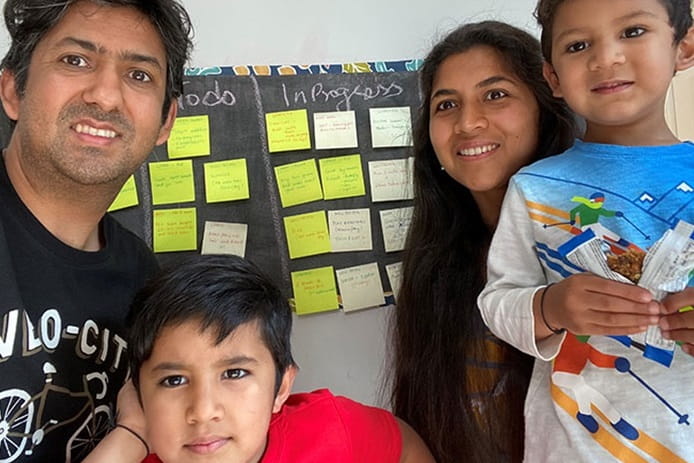Agile at home
Adapting Agile techniques for the home front
Sanjana and Hemant Chandak are systems engineers at Raytheon's campus in Tewksbury, Massachusetts. They are also the parents of two sons, ages 3 and 5, and they live with their young-adult nephew. When the stay-at-home orders came they found themselves in the same position as so many other parents: juggling their full-time jobs with the care and education of their kids.
That’s when Sanjana hit on an idea that has transformed their home life. Why not take the techniques she uses with her work team of eight engineers and adapt them to organize her family’s days and weeks? And with that, the Chandak household became the latest adopter of Agile, an approach to project management that emphasizes collaboration and constant adaptation to change.
“In the past, I applied some of the principles to everyday activities, so at the beginning of the COVID shutdown, I decided to try it again, to see what it would look like,” Sanjana said.
The approach has worked to help bring structure and keep the kids on task. While an Agile framework can get complicated, the basic principles just might help any home:
Determine your priorities
To focus everyone’s efforts on what matters most to the family, the Chandaks identified their key priorities.
“For us, work deadlines, learning goals and well-being are important,” Sanjana said.
Initially, the Chandaks also included home improvement, such as planting and growing herbs in their garden.
“That just didn’t work because we weren’t able to find the time,” Sanjana said. “If something isn’t working, it’s OK to scale back. It wasn’t getting done, so even though we had put it on our plate to see how we would do, it probably was not a priority. So we adjusted.”
Decide your sprint length
A key concept in Agile is the sprint — a defined amount of time when a team works to complete tasks. The timeframe can be weekly, biweekly or monthly. Sanjana set the family’s sprints at one-week cycles.
“With the kids being younger, we thought that was the best approach to match the attention spans for their ages,” she said.
Schedule scrum meetings
An Agile approach calls for planning meetings at the beginning of each sprint. In these meetings, called scrums — a term borrowed from rugby — you’ll assess what’s working and what’s not, and look ahead to the next sprint.
“We meet every Sunday and bring our goals for the following week,” Sanjana said. “The goals have to align with one of the key priorities.”
The kids’ goals involve things like completing worksheets, practicing the alphabet and biking and dancing, while the adults focus on exercise, reading and work projects. At this weekly meeting, you can also assign tasks and chores to be done the following week.
Hold a daily standup meeting
The Chandaks have brief daily standup meetings in the morning, when everyone is expected to answer three questions:
- What have I accomplished since our last meeting?
- What will I accomplish today?
- What obstacles are in my way?
While young children need plenty of guidance, it’s good to involve them in the process.
“Our five-year-old does writing worksheets,” Sanjana said. “If I don’t print them out, he can’t complete them. He has to remind me and say what he needs.”
Use visuals
When you add visual aids to auditory content, people perceive the information with two different senses, enhancing their ability to learn it. Spelling out words and showing relationships in a diagram form helps clarify material. The Chandaks keep their visual aids simple.
“We use a chalkboard to write down what everyone wants to accomplish for the week,” Sanjana said.
Take a look back
A monthly retrospective meeting offers the chance to consider what’s working and what’s not; a central part of Agile to adjust and improve as you go.
“We discuss how we could do better, and what hindrances may have occurred,” Sanjana said. “We involve the kids in the discussion, helping us solve problems.”
During one of their retrospective meetings, the family concluded that the kids didn’t necessarily have to finish every activity.
“As long as there is sense that they are learning, it’s OK,” Sanjana said. “Also, we decided that it’s OK to not rush and finish anything left from current sprint. It can be passed to the next one.”
So stay flexible and, like the Chandaks, you might find that Agile can help make the shutdown a smoother, more manageable experience for everyone.




